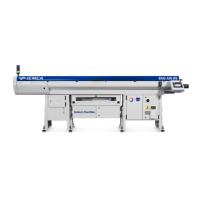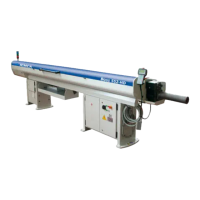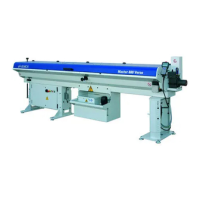Do you have a question about the IEMCA MINI BOSS 325 CNC and is the answer not in the manual?
Explains the manual's purpose, safety compliance, and quick search.
Details on identifying the manufacturer and bar feeder model, including key.
Information on contacting technical assistance departments for support.
Lists the supplementary documents included with the manual.
Provides a general overview of the BOSS automatic bar feeder and its models.
Details the sequence of movements during the automatic operation mode.
Describes the various safety devices installed on the bar feeder.
Explains the location and meaning of safety plates on the machine.
Details the different versions of the bar feeder and their specifications.
Presents overall dimensions and general technical specifications of the models.
Introduces optional devices to improve feeder performance and versatility.
Describes special devices for coupling with sliding headstock lathes.
Introduces special devices for coupling with cam lathes.
Emphasizes the importance of reading the manual for safety during operation.
Provides safety guidelines for handling and installing the bar feeder.
Outlines safety precautions for adjustments and setup operations.
Details safety measures for using and operating the bar feeder.
Specifies safety procedures for carrying out maintenance tasks.
Describes the three possible packaging options for the bar feeder.
Provides safety warnings and instructions for handling and lifting operations.
Details requirements for the installation area, including floor, lighting, and ventilation.
Step-by-step guide for installing the feeder without axial displacement.
Guide for installing the feeder with an axial displacement device.
Instructions for installing devices for sliding headstock lathes.
Instructions for installing devices for cam lathes.
Guidance on filling the lubricator with oil.
Details the electric connection procedure and safety warnings.
Instructions for connecting the pneumatic system.
Describes how to install an additional push-button panel.
Explains the self-learning process for dimensions based on lathe type.
Introduction to adjustments and setup procedures for the bar feeder.
Overview of general adjustments needed for optimal feeder operation.
Details how to set up the feeder based on bar diameter and machining type.
Describes the procedure for timing the cam box to its microswitch.
Explains the functions and layout of the main push-button panel.
Details the controls on the additional push-button panel.
Explains the meaning of the different indicator light colors.
Covers characteristics and preparation of bars for machining.
Sequence for initial feeder setup and starting the automatic cycle.
Describes how to stop the feeder in emergency or at work end.
Procedure to start the automatic cycle after manual operations.
Instructions for resuming automatic cycle after a power interruption.
Provides a quick guide for changing machining types.
General safety and maintenance rules for the bar feeder.
Details scheduled maintenance tasks based on hours or cycles.
Instructions on how to use the axial displacement device.
Lists common general faults, their causes, and cures.
Troubleshooting guide for issues related to the bar magazine.
Troubleshooting guide for problems with bar insertion into the collet.
Troubleshooting guide for issues encountered during bar feeding.
Information on replacing the feed chain (complex operation).
Instructions for replacing the primary chain and pinion.
Procedure for replacing the guide opening belt.
Guide for replacing the EEPROM chip.
Instructions for replacing electronic boards.
Procedure for replacing the feed motor drive.
Lists recommended spare parts for normal use over two years.
| Type | Automatic Bar Feeder |
|---|---|
| Bar Stock Shape | Round |
| Remnant Management | Automatic |
| Air Pressure | 6 bar |
| Minimum Bar Diameter | 3 mm |
| Bar Length | 3000 mm |
| Power Supply | 400 V, 50/60 Hz |
| Loading System | Bundle loader |


